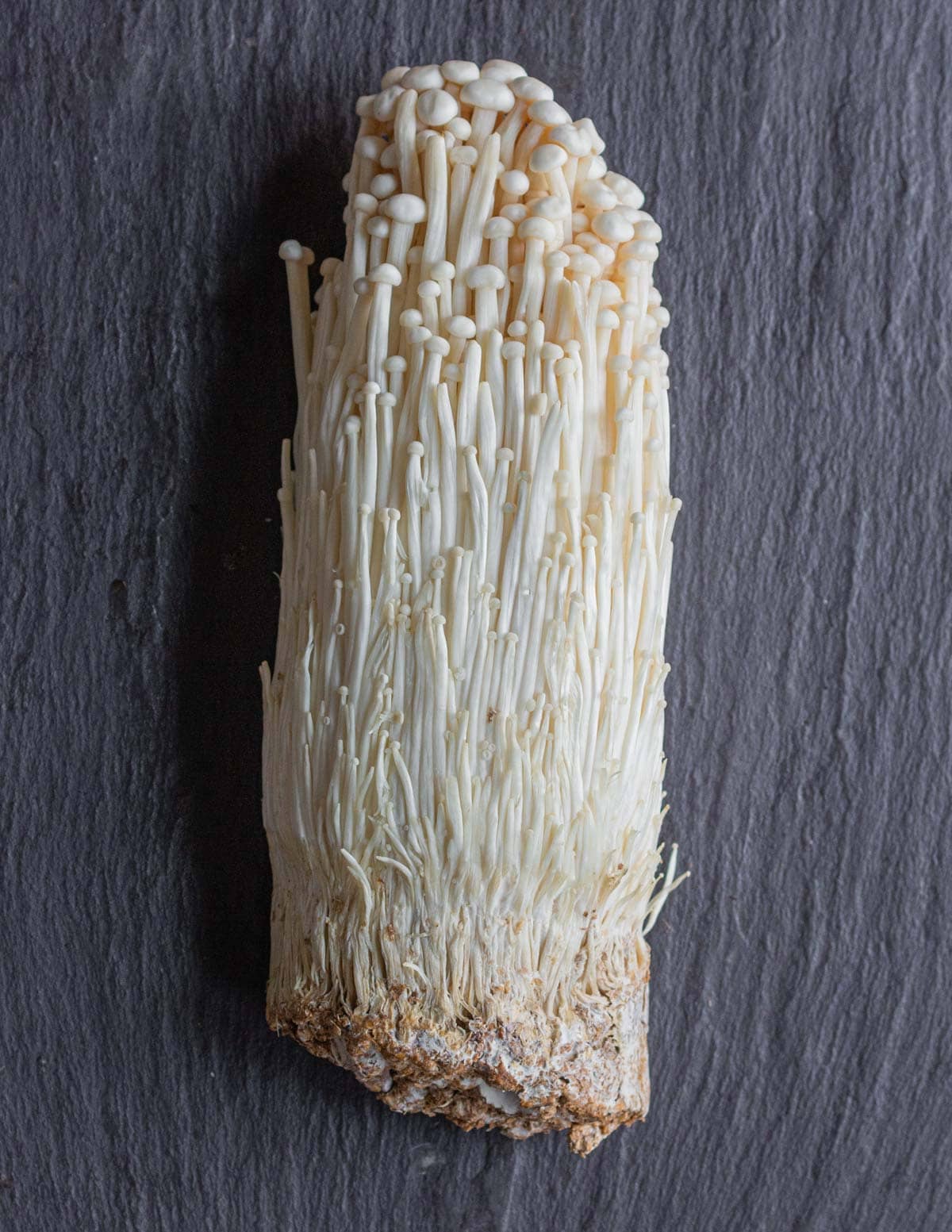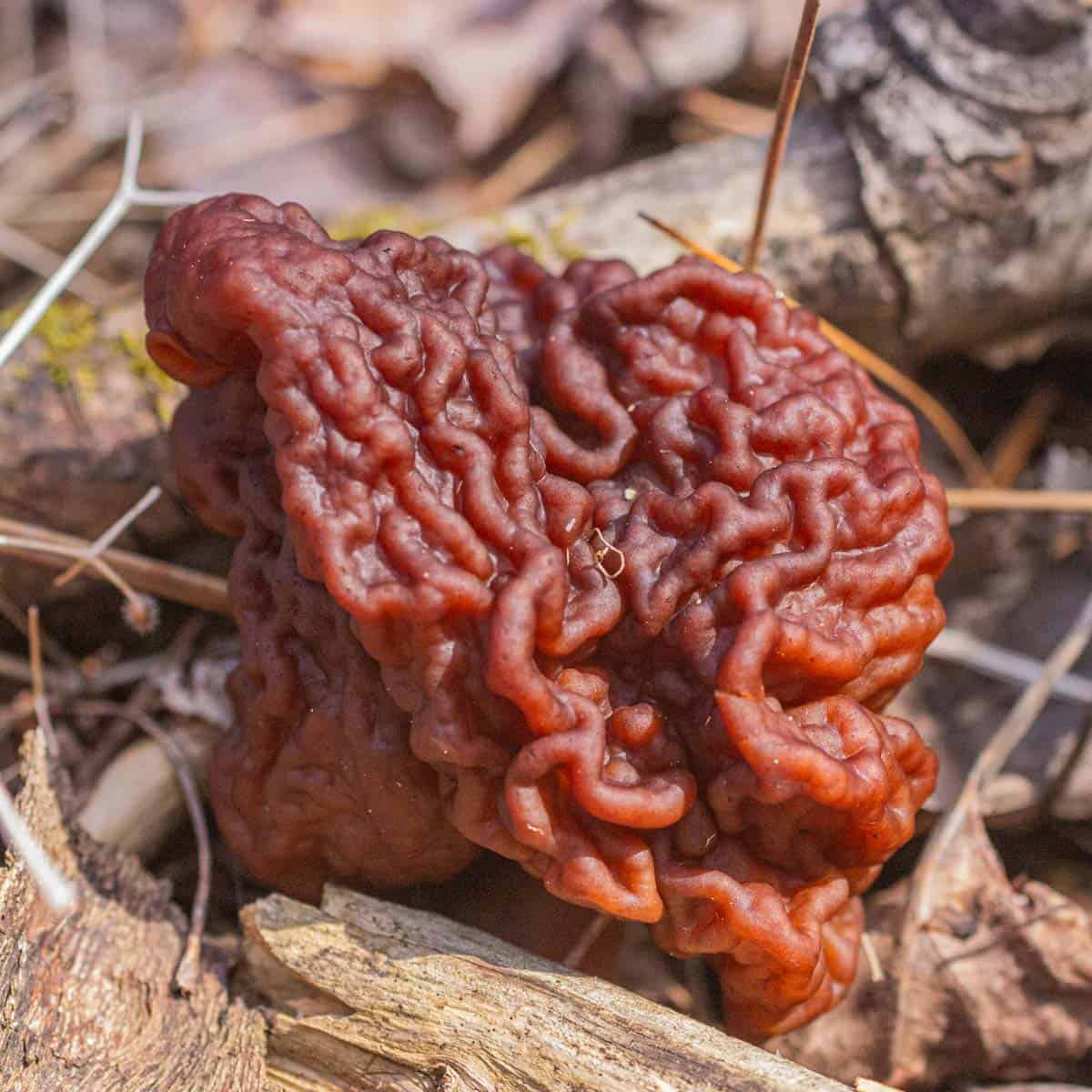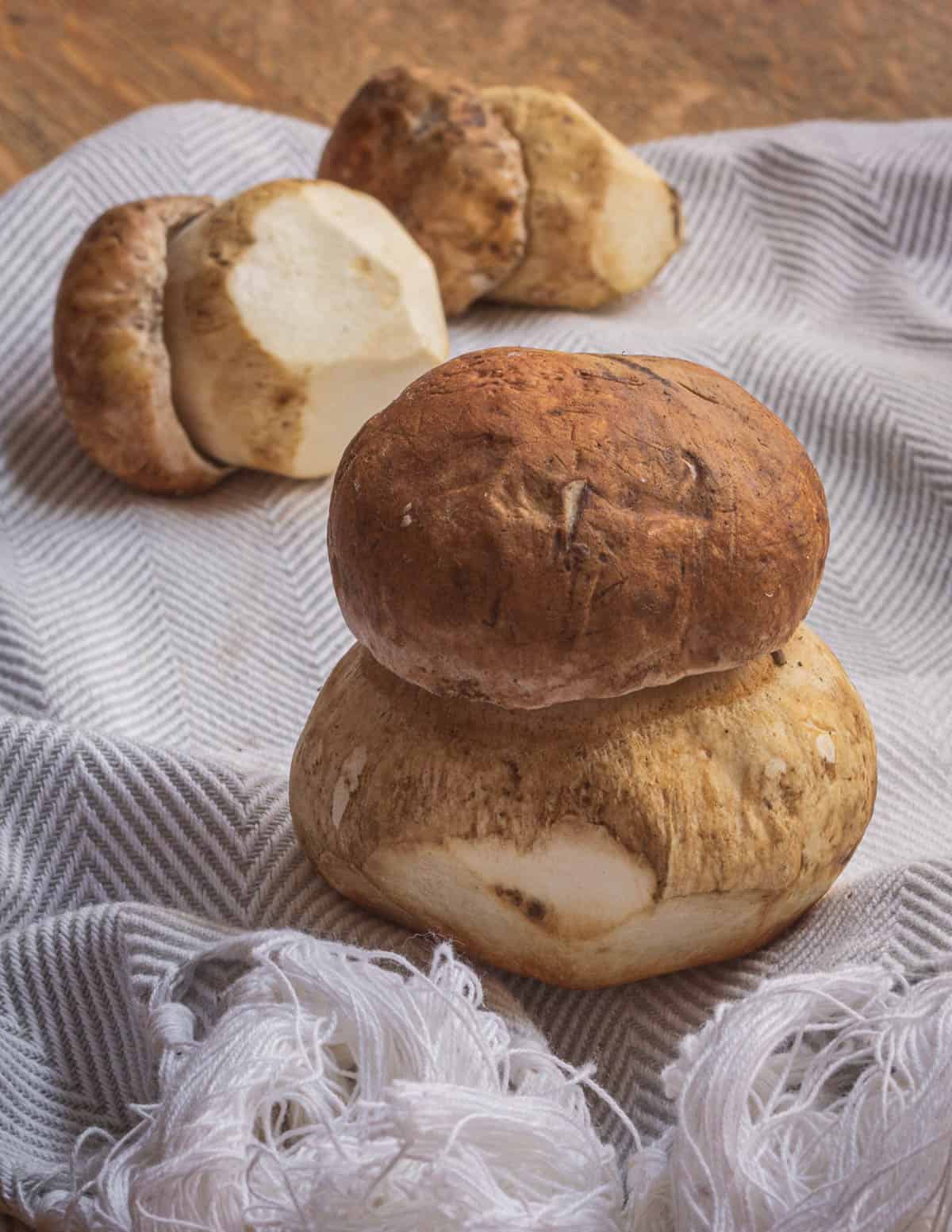Spring is an exciting time of year for foragers. While many people will be familiar with morels there's plenty of other varieties of edible wild mushrooms that grow in the spring. What you'll see depends on your location, the types of trees in the area, and especially, the rain. Here's a list of the most common species I come across. I'm from Minnesota but this list will apply to many other states.

Enokitake
Often the first mushroom to appear, long before morels. They're also known as the enoki and velvet shank mushroom. These are the same enoki found at your local Asian grocer.

Besides the common variety that grows on elm trees, there's also F. populicola, which grows on aspen which is often slightly larger in size.
When exposed to sunlight as they grow the mushrooms develop different colors than their thin, white cousins from the store. They can survive freezing and thawing and still be fine to eat.

Wood Ear
Just like the enoki, wood ear mushrooms are cold-adapted. They can freeze at night and thaw in the day, and I've literally picked them in the snow.

You'll see them growing on sticks and downed logs through the spring, summer and fall after heavy rains. They're edible and add a nice texture to soup or wood ear mushroom ramen.
Dryad Saddle Pheasant Back
Easy to identify, a little trickier to cook and eat. These polypore mushrooms with a pheasant tail pattern can appear in large numbers on dying box elder and elm trees around the same time as morels, if not a week or so before.

They make a good consolation prize when morels are scarce. Make sure to take a look at my tips for preparing them as cooking with them is a learned skill. I have a lot more information and techniques for working with them in my post on Pheasant Back / Dryad Saddle Mushrooms.
Golden Oyster
A relatively new mushroom in my region, the golden oyster mushrooms escaped from cultivation and has rapidly spread across the Upper Midwest.

They can be found in great numbers after rain and like to decompose elm, box elder, and the occasional cherry tree. Although some will disagree, I describe them as an invasive mushroom as their voracious fruiting resembles the patterns of other invasive species. Like all other oyster mushrooms they're delicious when young and bug-free.

Aspen Oyster
The classic spring oyster mushroom, Pluerotus populinus grows exclusively on aspen trees. They'll appear in the spring but can be found throughout the growing season. The best mushrooms are the early ones. As the season progresses it becomes hard to find them not riddled with fungal gnat larvae.

Gyromitra (False Morels)
Also known as early morels, this group of mushrooms are the most well-known morel look-alikes. There's a number of varieties Gyromitra that appear in the spring. An easy way to tell false morels vs morels is that morels are always hollow and Gyromitra are never hollow, but are filled with folds or cottony pith.

They're eaten in some places, and are probably the national mushroom of Finland, but require advanced knowledge and aren't for beginning foragers. Without thorough cooking all are poisonous mushrooms, just like morels.
But, thanks to the Alden study, we know that of the Gyromitra pictured in this post, only G. esculenta contains Gyromitrin / monomethylhydrazine-the compound also found in rocket fuel that must be cooked off before consumption. G. brunnea, G. korfii, and G. caroliniana can be eaten without boiling, but still aren't for beginners. The good part is they're good indicators of morel habitat.
G. Brunnea
Also known as the Elephant Ear mushroom from the appearance of their wavy lobes, these striking Gyromitra are common in broadleaf hardwood forests, especially maple sugar bush. Seeing them is a good indication morels could be near by. Like all others in the genera they're poisonous without proper processing and don't taste as good as morels.

G. Korfii / Montana
With it's orange color and exclusive growth with coniferous trees like red pines, Gyromitra korfii is relatively easy to separate from other spring mushrooms. It's comparable to Gyromitra gigas and Gyromitra montana, which are thought to have a lower concentration of Hydrazine compared to G. esculenta. I occasionally eat a few in moderation, but they're nothing as good as morels.

G. Esculenta
Once widely eaten across Europe and even sold in cans, Gyromitra esculenta is the most well-known species in the genus. It has one of the highest concentrations of Gyromitrin, it's still eaten and sold dried in places like Finland and places with Finnish immigrants settled like the Upper Peninsula of Michigan.

Although it can be rendered edible by boiling, it's responsible for numerous mushroom poisonings every year around the world. I don't eat them personally and can't recommend them.
G. Caroliniana
Known as the "Big Red" and erroneously as beefsteak mushroom, they grow throughout the South near dead hardwoods. I've eaten mushrooms from Mississippi and Missouri although they can grow as north as Ohio from what I know.

They have undetectable levels of Gyromitrin compared to other varieties. Some cook them without boiling but they're still an advanced-level mushroom and often riddled with pill bugs that take refuge in the inner folds.
Verpa Bohemica
Not a true morel, Verpas grow in the same habitat and are a good indication you're in the right area. They're edible when cooked thoroughly but some people can be sensitive to them and could experience upset stomachs, just like morels. There's two varieties as of this writing: V. bohemica with the wrinkled cap, and Verpa conica, with a smooth cap.

They're enjoyed in Europe and occasionally sold commercially in the United States on good years. They can be easily separated from true morels as they have a cottony pith inside, just like Gyromitra. Verpas are edible (and good) with thorough cooking, and their toxicity is essentially the same as morels.

Morels
The most famous spring mushroom of all, and the official state mushroom of my home state Minnesota. I'm sharing 3 types of true morels that are the most common to find where I live, but in reality there's 13 or more distinct species in North America. All morels must be thoroughly cooked to be edible and will make you sick undercooked.

Riverbank Morels
Also known as common morels, Morchella americana is the highly prized mushrooms most people will be familiar with. Many people refer to them as "grey and blonde" morels but they're actually the same mushroom.

The begin grey, and turn yellow with maturity. Morels grow with a wide variety of dead and dying trees and disturbed areas like logged woods. For more on them take a look at my guide to morel mushrooms.

Black Morels
Not as well known as the larger riverbank morel that comes in gold and grey colors, natural black morels are also more difficult to hunt. Some varieties cause allergic reactions when ingested with alcohol (M. septentrionalis) so be cautious if it's your first time harvesting them. Natural black morels are different from burn morels (M. augusticeps) that grow after forest fires.

Half-Free Morels
A true morel, half free morels (Morchella punctipes and semilibera) often show up at the same time verpas do. In rural areas they may be called "peckerhead mushrooms".
Just like verpas, they're a good indication that you're in the right area. As they come up a bit earlier than morels it's good to mark the location you found them to go back a week later, or after a rain to find the real deal.

They're easily separated from other morels as the cap is only half attached to the stem, as you can see in the image below.

Shaggy Mane
Shaggy manes (Coprinus comatus) are a delicious enigma, appearing whenever they please after heavy rains in spring, summer and fall, often in large numbers. The mushrooms grow in a variety of places like the edges of woods, trails with compacted soil and disturbed areas.

Another inky cap, Coprinus micaceous can also be found in the spring and is edible with a mild flavor. I see it more often in the spring than shaggy manes.

Others like Coprinopsis atramentaria should not be eaten as they contain a compound that becomes poisonous/toxic when consumed with alcohol. Read more about them in my longer article on foraging Shaggy Mane Mushrooms.
Chicken of the Woods
Mostly thought of as a summer and fall mushroom, the best flush of chicken mushrooms can be in the spring around the last week of may where I live. I have a large decaying oak stump that's fruited every Memorial day for the last 6 years.

There's two varieties where I live: white chicken mushrooms (Laetiporus cincinnatus) and yellow chickens (Laetiporus sulphureus). I have only seen the yellow variety at the end of Spring. Both are delicious, choice edibles when young and tender.

West Coast Spring Mushrooms
If you're on the west coast in places like California, Oregon or Washington you may have a few different mushrooms not available in the Midwest or on the East Coast. Here's two notable ones I've eaten.
Amanita Velosa
Also known as the Springtime Amanita, A. velosa is endemic to the West Coast and can be found growing near oaks in the spring. Related Amanitas like Amanita rubescens (edible) and A. ocreata (deadly poisonous) can be found in the same habitat from winter into spring.

I've picked them near San Francisco in April next to Cantharellus californicus. It has lethally poisonous looks a-likes and should only be harvested by expert mushroom identifiers. That said, it's also delicious and worth eating if you get the chance.
Boletus rex-veris
Also known as the spring king bolete, Boletus Rex-Veris is a prized edible cousin of other porcini mushrooms that appear later in the year. Also known as Spring King Boletes, they're usually available in May-June on the West Coast, growing under pine and fir trees, often buried under needles.

As fungal gnats aren't as much of an issue with them, they're one of the few bolete mushrooms that are sold commercially in large quantities to restaurants fresh instead of dried. They can be cooked like any other king bolete / porcini mushroom.

Laura
Reading through this post again and loving that you have f. Populicola… I was puzzling over finding what was clearly flammulina growing on aspen stumps. After consulting my books and multiple foraging groups this is where I found my answer! Thanks always for all the amazing information and … what’s your favourite mushroom guide(s)? I have so many and none seem quite comprehensive enough!
Alan Bergo
Hi Laura. The best guides can depend on your general location, but I really like Mushrooms of the Midwest by Michael Kuo. Just bought a copy for my favorite mushroom hunting buddy.
Jamie
Why omit chanterelles? One most delicious of all mycological wonders...
Alan Bergo
Chanterelles are a summer mushroom. This post is about spring mushrooms. When I finish my list of summer mushrooms they’ll be in it.
Sam Knutson
Funny, there are a couple fall mushrooms in here. The first comment being batted away because chanterelles are "summer mushrooms" in light of the inclusion of both enokitake and chicken of the woods's inclusion in an article about "spring mushrooms" is persnickety for no reason. Also of note, shaggy mane can be included in the hinted at tippler's bane category. All of the false morelles (Gyromitra) included in this article are both quite toxic if not fully cooked, and truly not that good to eat. It must have been a struggle to come up with 15.
Take good care. It seems as of you are encouraging people to eat these things while misinforming them for the sake of the number in the title.
People who are well informed can easily dismiss the majority of this article, but interested parties could be lead astray to spend hours in the woods gathering sickening and not good mushrooms, or looking for mushrooms that will be available in October.
Um... good job?
Alan Bergo
Sam, part of what I wanted to share here is that what exactly a spring mushroom is can be confusing. Enokitake come up through the year, but the best flushes are in the spring. Chanterelles, on the other hand, are most definitely not a spring mushroom and we usually start to see them in July. Chicken of the woods is included at the end for fun, since every year in the mushrooms I admin on FB, we get ID requests (there's numerous ones right now) about May chicken of the woods since people can't believe they would come up so early. The chickens always come here if it's a wet spring. The title of the post is also just "spring mushrooms", note that edible is not in the title. As for the Gyromitra, you need to keep up on the science and read the Alden Study. A new method has been developed for Gyromitrin testing, and all the species I include here, with the exception of G. esculenta have undetectable levels of Gyromitrin. I am quite clear that they're advanced level mushrooms in this post, and they're important to include as they're morel habitat indicators, and morels are definitely the superior mushrooms, imo.
Augury86
I'm sorry but the huge amount of cinnabar and golden chantarelles I've gathered so far would beg to differ with your highly localized knowledge.
Alan Bergo
This website focuses on the Upper Midwest since that’s where I live. The earliest I’ve ever found chants here is around June 14. The earliest I’ve found chicken of the woods here is the 3-4 week of May. Chicken of the woods are included in the spring list as they dependably fruit in late May here-and many people find that information helpful as they’re usually only described as a summer or fall mushroom. If chanterelles fruited here in May every year they’d be included too.
H Potter
I appreciate that your experience differs from Alan's; but there are ways to disagree, add perspective, or encourage further conversation that are helpful without (even if inferred) being condescending. I have also blissfully found so many other mushrooms in spring, but appreciate this short list to focus on as I am admittedly an uneducated wanderer hoping to learn foraging one gift of nature at a time. He does state when a species should be handled by experts or has many look alikes. Do you have any photos of chanterelles found in Spring? I would love to see the bounty of your region 🙂
Mark
Sam, in mid-April, white-pored COTW produces flushes in two locations, a couple of miles from my Saint Louis home. Augury, despite the early heat and heavy rainfall in MO, I’ve never seen Cantharellus before July. Deeply skeptical of Spring chants, but I love surprises. I’m sure gonna be looking from now on!